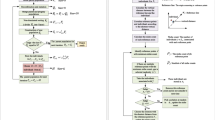Abstract
As an evolutionary approach to solve constrained multi-objective optimization problems (CMOPs), recently an algorithm using the two-stage non-dominated sorting and the directed mating (TNSDM) was proposed. In TNSDM, the directed mating utilizes infeasible solutions dominating feasible solutions in the objective space to generate offspring. The directed mating significantly contributes to the search performance improvement in evolutionary constrained multi-objective optimization. However, the conventional directed mating has two problems. First, since the conventional directed mating selects a pair of parents based on the conventional Pareto dominance, two parents having different search directions may be mated. Second, the directed mating cannot be performed in some cases especially when the population has few useful infeasible solutions. In this case, the conventional mating using only feasible solutions is performed instead. Thus, the effectiveness of the directed mating cannot always be achieved depending on the number of useful infeasible solutions. To overcome these problems and further enhance the effect of the directed mating in TNSDM, in this work we propose a method to control the selection area of useful infeasible solutions by controlling dominance area of solutions (CDAS). We verify the effectiveness of the proposed method in TNSDM, and compare its search performance with the conventional CNSGA-II on discrete m-objective k-knapsack problems and continuous mCDTLZ problems. The experimental results show that the search performance of TNSDM is further improved by controlling the selection area of useful infeasible solutions in the directed mating.
Similar content being viewed by others
Explore related subjects
Discover the latest articles, news and stories from top researchers in related subjects.References
Deb, K: Multi-Objective Optimization using Evolutionary Algorithms. John Wiley & Sons (2001)
Coello, C.A.C., Lamont, G.B., Veldhuizen, D.A.V.: Evolutionary Algorithms for Solving Multi-Objective Problems, 2nd edn. Springer, New York (2007)
Chinchuluun, A., Migdalas, A., Pardalos, P.M., Pitsoulis, L.: Pareto Optimality, Game Theory and Equilibria. Springer (2008)
Mezura-Montes, E.: Constraint-Handling in Evolutionary Optimization. Springer (2009)
Hoffmeister, F., Sprave, J.: Problem-independent handling of constraints by use of metric penalty functions. In: Proceedings of the 5th Annual Conference on Evolutionary Programming (EP 1996), pp. 289–294 (1996)
Bäck, T., Hoffmeister, F., Schwefel, H.: A survey of evolution strategies. in: Proceedings of the 4th International Conference on Genetic Algorithms, pp. 2–9 (1991)
Coello, C.A.C., Christiansen, A.D.: MOSES: A multiobjective optimization tool for engineering design. Eng. Optim. 31(3), 337–368 (1999)
Zitzler, E., Thiele, L.: Multiobjective evolutionary algorithms: A comparative case study and the strength Pareto approach. IEEE Trans. Evol. Comput. 3(4), 257–271 (1999)
Ishibuchi, H., Kaige, S.: Effects of repair procedures on the performance of EMO algorithms for multiobjective 0/1 knapsack problems. In: Proceedings of the 2003 Congress on Evolutionary Computation (CEC’2003), vol. 4, pp. 2254–2261 (2003)
Homaifar, A., Lai, S.H.Y., Qi, X.: Constrained optimization via genetic algorithms. Trans. Soc. Model. Simul. Int. 62(4), 242–254 (1994)
Joines, J., Houck, C.: On the use of non-stationary penalty functions to solve nonlinear constrained optimization problems with gas. In: Proceedings of the First IEEE Conference on Evolutionary Computation, pp. 579–584 (1994)
Farmani, R., Wright, J.A.: Self-adaptive fitness formulation for constrained optimization. IEEE Trans. Evol. Comput. 7(5), 445–455 (2003)
Deb, K.: Evolutionary algorithms for multi-criterion optimization in engineering design. In: Evolutionary Algorithms in Engineering and Computer Science, chapter 8, pp. 135–161. John Wiley & Sons (1999)
Hazra, J., Sinha, A.K.: A multi-objective optimal power flow using particle swarm optimization. Eur. Trans. Electrical Power 21(1), 1028–1045 (2011)
Woldesenbet, Y.G., Yen, G.G., Tessema, B.G.: Constraint handling in multiobjective evolutionary optimization. IEEE Trans. Evol. Comput. 13(3), 514–525 (2009)
Mezura-Montes, E., Coello, C. A. C. : Constrained optimization via multiobjective evolutionary algorithms. In: Multiobjective Problem Solving from Nature, Part I, pp. 53–75. Springer (2008)
Deb, K., Pratap, A., Agarwal, S., Meyarivan, T.: A fast and elitist multi-objective genetic algorithm: NSGA-II. IEEE Trans. Evol. Comput. 6, 182–197 (2002)
Miyakawa, M., Takadama, K., Sato, H.: Two-stage non-dominated sorting and directed mating for solving problems with multi-objectives and constraints. In: Proceedings of 2013 Genetic and Evolutionary Computation Conference (GECCO 2013), pp. 647–654 (2013)
Sato, H., Aguirre, H., Tanaka, K.: Controlling dominance area of solutions and its impact on the performance of MOEAs. In: Proceedings 4th International Conference on Evolutionary Multi-Criterion Optimization (EMO2007), Lecture Note in Computer Science (Springer), vol. 4403, pp. 5–20 (2007)
Ishibuchi, H., Tsukamoto, N., Nojima, Y.: Evolutionary many-objective optimization: A short review. In: Proceedings of 2008 IEEE congress on evolutionary computation (CEC2008), pp. 2424–2431 (2008)
Kellerer, H., Pferschy, U., Pisinger, D.: Knapsack Problems. Springer (2004)
Deb, K., Thiele, L., Laumanns, M., Zitzler, E.: Scalable multi-objective optimization test problems. In: Proceedings of 2002 IEEE Congress on Evolutionary Computation (CEC2002), pp. 825–830 (2002)
Miyakawa, M., Takadama, K., Sato, H.: Controlling selection area of useful infeasible solutions in directed mating for evolutionary constrained multiobjective optimization. In: Proceedings of the 8th Learning and Intelligent OptimizatioN Conference (LION 8), Springer, LNCS 8426, pp. 137–152 (2014)
Ray, T., Tai, K., Seow, C.: An evolutionary algorithm for multiobjective optimization. Eng. Optim. 33(3), 399–424 (2001)
Kukkonen, S., Lampinen, J.: Constrained real-parameter optimization with generalized differential evolution. In: Proceedings of 2006 IEEE Congress on Evolutionary Computation (CEC2006), pp. 911–918 (2006)
Gao, W., Yen, G.G., Liu, S.: A novel differential evolution for constrained optimization. In: Proceedings of 2014 IEEE international conference on systems, man and cybernetics, pp. 2433–2438 (2014)
Sato, H., Aguirre, H., Tanaka, K.: Variable space diversity, crossover and mutation in MOEA solving many-objective knapsack problems. Ann. Math. Artif. Intell. 68, 197–224 (2013)
Ishibuchi, H., Narukawa, K., Tsukamoto, N., Nojima, Y.: An empirical study on similarity-based mating for evolutionary multiobjective combinatorial optimization. Eur. J. Oper. Res. 188, 57–75 (2008)
Watanabe, S., Hiroyasu, T., Miki, M.: Neighborhood cultivation genetic algorithm for multiobjective optimization problems. In: Proceedings of Genetic and Evolutionary Computation Conference (GECCO2002), pp. 458–465 (2002)
Zhang, Q., Li, H.: MOEA/D: A multi-objective evolutionary algorithm based on decomposition. IEEE Trans. Evol. Comput. 11(6), 712–731 (2007)
Fain, H., Deb, K.: An evolutionary many-objective optimization algorithm using reference-point based nondominated sorting approach, Part II: Handling constraints and extending to an adaptive approach. IEEE Trans. Evol. Comput. 18(4), 602–622 (2014)
Zitzler, E.: Evolutionary Algorithms for Multiobjective Optimization: Methods and Applications, PhD thesis. Swiss Federal Institute of Technology, Zurich (1999)
Sato, M., Aguirre, H., Tanaka, K.: Effects of δ-similar elimination and controlled elitism in the NSGA-II multiobjective evolutionary algorithm. In: Proceedings of 2006 IEEE congress on evolutionary computation (CEC2006), pp. 1164–1171 (2006)
Author information
Authors and Affiliations
Corresponding author
Rights and permissions
About this article
Cite this article
Miyakawa, M., Takadama, K. & Sato, H. Controlling selection areas of useful infeasible solutions for directed mating in evolutionary constrained multi-objective optimization. Ann Math Artif Intell 76, 25–46 (2016). https://doi.org/10.1007/s10472-015-9455-9
Published:
Issue Date:
DOI: https://doi.org/10.1007/s10472-015-9455-9
Keywords
- Evolutionary multi-objective optimization
- Constraint-handling
- Directed mating
- Control of the dominance area




